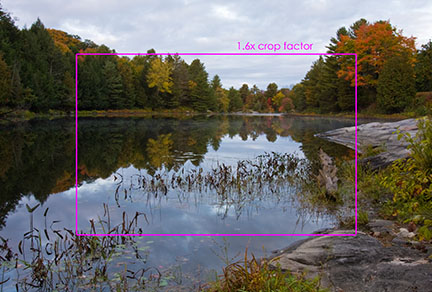Digital Camera Basics III:
Sensors
Learn a few digital camera basics. Understand what a sensor is. Find out the difference between a full-frame sensor and cropped sensor, and which one is right for you. Discover what a crop factor is.
What is a Sensor?
How your camera’s sensor works is basic photography information that every photographer should know. The image sensor on your camera converts an optical image to an electrical signal. It is the digital equivalent of film, in that it is the light-sensitive recording medium of the image. An image sensor is typically one of two kinds: a CCD (charge-coupled device), or a CMOS (complementary metal–oxide semiconductor).
CCD is a technology that has been around for over twenty years. CCD sensors are found on digital cameras that produce high quality images. CMOS is a much newer and less expensive technology, and its arrival has contributed to the drop in prices of digital cameras. Since their introduction for inexpensive point and shoot cameras, CMOS sensor have vastly improved in quality and are now found in high end digital cameras as well. Both technologies can produce excellent images, and the sensor type should not be a deciding factor in which camera you buy.
Full Frame Camera versus Cropped Sensors
Digital Camera Basics: Sensor Sizes
Camera sensors are available in a variety of sizes, and size does matter!
A number of higher-end DSLR cameras have "full frame" sensors, which means they are equivalent in size to 35mm film. The sensor measure 36mm in width by 24mm in height, giving a 3:2 aspect ratio. Full frame camera sensors include the Canon 1Ds and 5D series and the Nikon D3 and D700.
Other DSLR cameras are made with sensors that are smaller. These are referred to as having a crop factor.
The crop factor is the sensor’s diagonal size compared to a full-frame 35 mm sensor. For Canon cameras like the 50D and 7D, the crop factor is 1.6. For Nikon cameras like the D40X and D300, it is 1.5.
The reason for the name "crop factor" is because when you are shooting with a 35mm lens, the sensor effectively crops out that much of the outside edge of the image because of the smaller sensor size.

© Julie Waterhouse Photography
Throwing away the outer part of the image is not all bad. Lenses are typically sharpest in the middle of the image, so with a cropped sensor, you are throwing away the least sharp part of the image, which can be helpful when using low quality lenses.
Digital Camera Basics: Effective Length of Your Lenses
The focal length multiplier of a lens is equal to the crop factor. It relates the focal length of a lens used with a smaller sensor to that of a lens used with a full frame camera sensor that produces the equivalent angle of view. For example, a 100mm lens used on a sensor with a 1.6x crop factor would produce the same field of view as a 1.6×100 = 160mm lens on a full frame sensor.
This means that when using a cropped sensor, you are forced to use a wider angle lens to produce the same angle of view as you would get with a larger sensor.
Be careful with the term "focal length multiplier," as it is somewhat misleading. The focal length of the lens does not change, no matter what size of sensor it is used with. Only the angle of view changes.
Digital Camera Basics: Impact of Sensor Size on Image Quality
Image sensor size might be a more important factor, in terms of its impact on image quality, than the number of megapixels it can record.
Image sensor size affects depth of field, dynamic range, and noise. Let’s examine each one.
Depth of field. Depth of field is much shallower for larger format sensors. Why? In order to fill the frame with your subject, a larger sensor means that you have to move closer to your subject, or use a longer focal length lens. Correspondingly, the depth of field will decrease for a given aperture. This means that your must use progressively smaller apertures in order to maintain the same depth of field with larger sensors.
Dynamic Range. Dynamic range is the range from light to dark in an image, outside of which, whites become "blown out" and blacks become "blocked up" with no texture or detail. Larger sensors generally (although not always) contain larger pixels. Larger pixels have greater volume, and can hold more photons of light. This generally gives them greater dynamic range.
Noise. Sensor size can also impact noise. Larger pixels (usually found on larger sensors) receive a greater amount of light over a given exposure duration (at a fixed aperture), so their light signal is much stronger, producing a higher signal to noise ratio, and a less noisy image.
I hope those digital camera basics were helpful!
Next, you may want to visit the first digital photography basics page to learn more about noise.